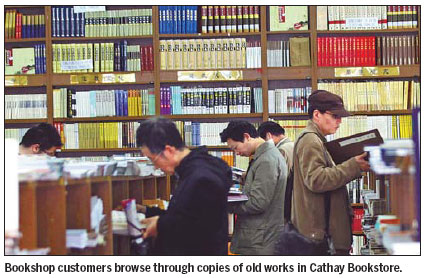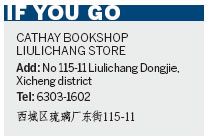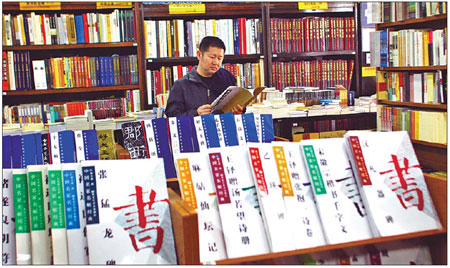Life
Flipping for old books
By Han Bingbin (China Daily)
Updated: 2011-04-06 08:06
 |
Large Medium Small |
|
Cathay Bookshop sells original and copied version of ancient books. It has collected more than 6 million volumes so far. [Photo/China Daily] |

Beijing's Cathay Bookshop hunts down and fixes up rare editions, Han Bingbin discovers.
Playing out their own genre of a literary quest, buyers from the Cathay Bookshop scour the world to track down and bring home China's ancient writings, volume by volume. Since the early 1990s, buyers at the bookshop have traveled to almost every corner of the world in search of China's scattered cultural relics.
Unlike a diplomatic delegation landing to the warm welcome of a band, this tightly-budgeted business team sacrifices lunchtime to search every nook, cranny and shop of a city.
"As a company, we should try to avoid getting irrational. To successfully obtain a piece, we have to strictly follow market regulations to negotiate a fair price," said Yu Huagang, manager of Cathay Bookshop, which sells original and copied versions of rare ancient books, stone inscriptions, paintings and calligraphy, which have been gathered from the hands of collectors worldwide.
So far, the bookshop has collected more than 6 million volumes of ancient books. More than 5,000 of these are deemed very rare, and 2,000 have been enshrined in national museums.
When a valuable book is acquired, it goes through the skill-demanding process of being repaired. Some of the refurbished books will be put onto the market, while for those deemed to be very rare versions the bookshop will make and sell photocopies. Even for books they fail to obtain because of price disagreement, the bookshop has an auction house to help owners put their collections under the hammer.
The bookshop has repaired more than 400,000 volumes of books for the country's museums. And its auction house has been holding regular events every spring and fall.
For manager Yu, he sees the role of the bookstore as "the inheritor of Beijing's antique book industry".
The capital's antique book industry dates back to the Liao Dynasty (AD 916-1125), when a group of venders and book stands began to sell books from previous dynasties - books that were at first mostly collected from common people. The industry entered its golden age during the Ming (1368-1644) and Qing (1644-1911) dynasties when there was a rapid increase in both the quantity and diversity of books. It was then that the city's Liulichang street matured into a book-vending hub.
In the early 20th century, when the introduction of new print technology nurtured an array of new books and bookstores, the antique book industry began to become old and ignored. Then in the very early days after the founding of New China in 1949, the industry's marginalized situation worsened into a crisis: antique bookstores were shut down and many valuable ancient books ended up in garbage dumps waiting to be burned.
A group of literati then set off alarms, calling on government to establish a State-owned antique bookshop to save the industry's dying history, and in 1952 the Cathay Bookshop was born. In 1958, the bookshop consolidated all 111 privately-run antique bookshops in town and laid the foundation for what it is now - a time-honored bookshop based in Liulichang with 15 chain stores citywide.

For centuries, the country's antique book industry with its large store of historical and academic files was generously called the "nutrition source" for China's intellectuals. For example, Lu Xun, the most renowned and respected writer in early 20th century China, recorded in his diaries that he visited Liulichang to buy books as many as 480 times during his 14-year stay in Beijing.
Yu is proud that Cathay Bookshop has inherited that cultural and spiritual legacy - a large number of its customers and visitors are academic and literary people who know the bookshop provides a cultural reference that can be found nowhere else. Some of these knowledgeable book buyers have become regular customers and good friends.
"Their old shop assistants truly know books," Wang Xuetai, a professor at the Chinese Academy of Social Sciences and a loyal visitor at the bookshop, told local media.
"They are very familiar with the different versions of books. In the old times, the bookshop used to have a tradition of sending books to scholars. The bookshop didn't have to ask what these scholars needed because the assistants knew their specific fields of expertise. In this regard, the bookshop has truly played a significant role in promoting traditional culture."
However, the bookshop now finds itself endangered by the rapid development of modern society. Amid the wave of building demolitions, the number of the bookshop's stores has reportedly fallen from 25 in the early 1990s to only 15 now.
"We totally understand that the city needs to develop and we're willing to support its development. But the protection and development of Beijing's traditional culture should also be a key element of city reconstruction. I think the government should really take a look at how Cathay Bookshop can survive and whether the 1,000-year cultural thread of Beijing's antique book industry will be snapped by our generation," Yu once complained to media.
To save the bookshop, Yu has been thinking about a much larger space that would accommodate more books, which he currently wants to name the "Cathay Bookshop Antique Book Building".
"Of course, everything is simply a tentative idea now," Yu said. "I only hope that this book building can be made a reality within our generation. That'll be our responsibility toward our ancestors, decedents, readers and also the whole antique book industry."
| 分享按钮 |
